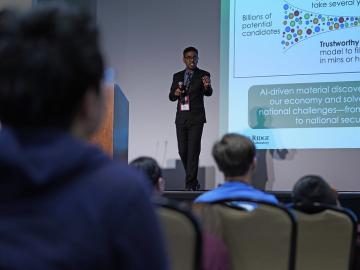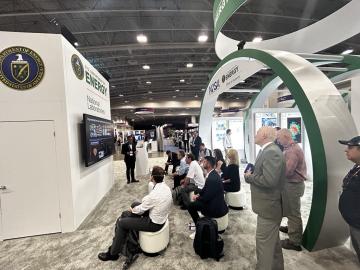
Filter News
Area of Research
- Advanced Manufacturing (1)
- Biology and Environment (12)
- Clean Energy (14)
- Computational Biology (1)
- Computational Engineering (1)
- Computer Science (6)
- Electricity and Smart Grid (1)
- Fuel Cycle Science and Technology (1)
- Functional Materials for Energy (1)
- Fusion and Fission (1)
- Isotopes (1)
- Materials (12)
- Materials for Computing (1)
- National Security (42)
- Neutron Science (8)
- Supercomputing (43)
News Topics
- (-) Artificial Intelligence (101)
- (-) National Security (72)
- (-) Statistics (3)
- 3-D Printing/Advanced Manufacturing (128)
- Advanced Reactors (34)
- Big Data (60)
- Bioenergy (92)
- Biology (101)
- Biomedical (61)
- Biotechnology (24)
- Buildings (67)
- Chemical Sciences (73)
- Clean Water (31)
- Climate Change (105)
- Composites (30)
- Computer Science (198)
- Coronavirus (46)
- Critical Materials (29)
- Cybersecurity (35)
- Decarbonization (85)
- Education (5)
- Element Discovery (1)
- Emergency (2)
- Energy Storage (112)
- Environment (200)
- Exascale Computing (42)
- Fossil Energy (6)
- Frontier (45)
- Fusion (58)
- Grid (66)
- High-Performance Computing (93)
- Hydropower (11)
- Irradiation (3)
- Isotopes (57)
- ITER (7)
- Machine Learning (50)
- Materials (147)
- Materials Science (146)
- Mathematics (9)
- Mercury (12)
- Microelectronics (4)
- Microscopy (51)
- Molten Salt (9)
- Nanotechnology (60)
- Net Zero (14)
- Neutron Science (137)
- Nuclear Energy (111)
- Partnerships (51)
- Physics (64)
- Polymers (33)
- Quantum Computing (37)
- Quantum Science (72)
- Renewable Energy (2)
- Security (25)
- Simulation (51)
- Software (1)
- Space Exploration (25)
- Summit (59)
- Sustainable Energy (130)
- Transformational Challenge Reactor (7)
- Transportation (99)
Media Contacts

As a data scientist, Daniel Adams uses storytelling to parse through a large amount of information to determine which elements are most important, paring down the data to result in the most efficient and accurate data set possible.

Despite strong regulations and robust international safeguards, authorities routinely interdict nuclear materials outside of regulatory control. Researchers at ORNL are exploring a new method that would give authorities the ability to analyze intercepted nuclear material and determine where it originated.

Prasanna Balaprakash, a national leader in artificial intelligence, or AI, spoke to some of the highest achieving students in the country at the National Science Bowl in Washington D.C.

ORNL researchers and communications specialists took part in the inaugural AI Expo for National Competitiveness in Washington D.C, May 7 and 8, to showcase and provide insight into how the lab is leading the way for utilizing the vast possibilities of AI.

John Lagergren, a staff scientist in Oak Ridge National Laboratory’s Plant Systems Biology group, is using his expertise in applied math and machine learning to develop neural networks to quickly analyze the vast amounts of data on plant traits amassed at ORNL’s Advanced Plant Phenotyping Laboratory.

Vanderbilt University and ORNL announced a partnership to develop training, testing and evaluation methods that will accelerate the Department of Defense’s adoption of AI-based systems in operational environments.

Researchers tackling national security challenges at ORNL are upholding an 80-year legacy of leadership in all things nuclear. Today, they’re developing the next generation of technologies that will help reduce global nuclear risk and enable safe, secure, peaceful use of nuclear materials, worldwide.

A team led by researchers at ORNL explored training strategies for one of the largest artificial intelligence models to date with help from the world’s fastest supercomputer. The findings could help guide training for a new generation of AI models for scientific research.

Researchers at the Department of Energy’s Oak Ridge National Laboratory met recently at an AI Summit to better understand threats surrounding artificial intelligence. The event was part of ORNL’s mission to shape the future of safe and secure AI systems charged with our nation’s most precious data.

ORNL researchers have produced the most comprehensive power outage dataset ever compiled for the United States. This dataset, showing electricity outages from 2014-22 in the 50 U.S. states, Washington D.C. and Puerto Rico, details outages at 15-minute intervals for up to 92% of customers for the eight-year period.


